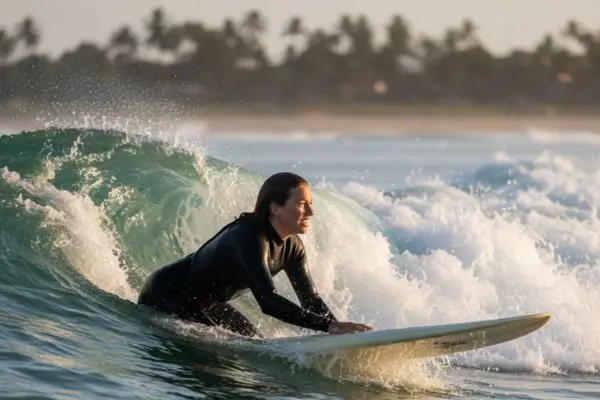One of the most exciting milestones in a surfer’s journey is the first successful takeoff — the moment you paddle, rise, and glide on the face of a wave. For women beginners, this skill can feel both thrilling and frustrating. Often, it is not strength or balance that stands in the way, but timing.
Understanding when to start paddling, how to commit, and the exact instant to stand up makes the difference between missing a wave and riding it with confidence.
Why Timing Matters
The ocean moves constantly. A wave is not a static ramp waiting for you — it is a moving force that requires synchronization. Beginners who hesitate often miss waves entirely, while those who rush end up diving over the front. Proper timing ensures efficiency, safety, and a much higher success rate.
Recognizing the Right Wave
Before practicing takeoff, women beginners should learn to identify waves that are most forgiving.
- Gentle, rolling waves give more time to react.
- Medium-sized sets provide enough push without being overwhelming.
- Waves with a clear shoulder allow room to practice without closing out too quickly.
By choosing the right wave, timing becomes easier to understand and refine.
The Paddling Phase
The takeoff begins long before standing up. Paddling sets the rhythm and speed necessary to match the wave.
- Start Early: Begin paddling when the wave is still behind you, not when it is already breaking.
- Build Momentum: Strong, consistent strokes help the board catch the wave’s energy.
- Commit Fully: Half-hearted paddling leads to missed opportunities.
The Critical Moment: Catching the Wave
As the wave begins to lift the tail of your board, you enter the crucial moment of timing.
- Feel the Push: Notice when the board starts to accelerate on its own.
- One Last Stroke: Often, a final powerful paddle ensures you lock into the wave.
- Eyes Forward: Looking where you want to go helps prepare your body for the next step.
Standing Up at the Right Time
The biggest challenge for beginners is knowing exactly when to transition from paddling to standing.
- Too Early: The board stalls, and the wave passes underneath.
- Too Late: The nose digs into the water, resulting in a wipeout.
- Just Right: The instant the board glides downhill with the wave, push up and place your feet.
A helpful trick is to practice the “pop-up” motion on the beach before entering the water, reinforcing the muscle memory.
Common Errors and How to Avoid Them
- Hesitation: Waiting too long creates missed waves. Solution: commit and trust your instincts.
- Slow Pop-Up: Taking too much time to stand makes the board unstable. Solution: practice quick transitions on land.
- Looking Down: This shifts weight forward. Solution: keep your head up and eyes ahead.
Building Consistency
Timing the takeoff is not mastered in one session. Consistency comes through repetition and observation.
- Practice in Whitewater: These smaller waves provide a forgiving environment.
- Watch Experienced Surfers: Notice the exact moment they stand up.
- Record Progress: Videos or notes can highlight subtle improvements over time.
Growing with Confidence
For women beginners, learning to time the takeoff is more than a technical step. It is an exercise in trust — trust in your board, in your body, and in your ability to read the rhythm of the ocean. With patience, practice, and persistence, each attempt brings you closer to that exhilarating feeling of standing up smoothly and riding your first clean wave.
Mastering timing transforms surfing from frustrating to fulfilling. And once you catch that perfect takeoff, you’ll realize that every stroke, every fall, and every lesson was preparing you for that moment of flow between you and the ocean.




